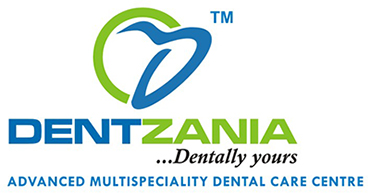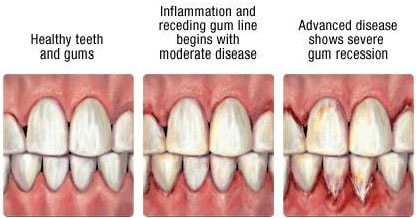WHAT IS GUM DISEASE ???
WHAT IS GUM DISEASE???
Gum disease is an inflammation of the gum line that can progress to affect the bone that surrounds and supports your teeth. The three stages of gum disease — from least to most severe — are gingivitis, periodontitis and advanced periodontitis.
ADVANCED GUM DISEASE (Periodontitis)
It is a progressive inflammatory disease of the gums and the surrounding tissue around the teeth. It is commonly known as gum disease and was referred to as pyorrhea in the old days. It is estimated that up to 80% of the population above the age of 40 may suffer from this disease with the severity varying drastically from one person to another. Periodontitis is the number one cause of tooth loss after the age of 40.
Certain medical conditions or medications can make you more susceptible to gum disease. They include pregnancy, diabetes, epilepsy, and such medications as chemotherapy, birth control pills, antidepressants, and those for heart problems.
Signs & Symptoms
Gum disease can be painless, so it is important to be aware of any of the following symptoms:
Gum disease is an inflammation of the gum line that can progress to affect the bone that surrounds and supports your teeth. The three stages of gum disease — from least to most severe — are gingivitis, periodontitis and advanced periodontitis.
ADVANCED GUM DISEASE (Periodontitis)
It is a progressive inflammatory disease of the gums and the surrounding tissue around the teeth. It is commonly known as gum disease and was referred to as pyorrhea in the old days. It is estimated that up to 80% of the population above the age of 40 may suffer from this disease with the severity varying drastically from one person to another. Periodontitis is the number one cause of tooth loss after the age of 40.
Certain medical conditions or medications can make you more susceptible to gum disease. They include pregnancy, diabetes, epilepsy, and such medications as chemotherapy, birth control pills, antidepressants, and those for heart problems.
Signs & Symptoms
Gum disease can be painless, so it is important to be aware of any of the following symptoms:
- Swollen, red, tender or bleeding gums
- Gums that recede or move away from the tooth
- Persistent bad breath or bad taste in mouth
- Loose teeth
- Visible pus surrounding the teeth and gums
As you brush your teeth, you might notice a bit of redness around your gums. While you might be tempted to ignore the blood, bleeding gums is an early sign of gum disease . The bleeding is due to inflammation in the gums caused by build-up plaque or overly vigorous brushing. If you notice some blood when you brush or floss, it is essential that you see a dentist.
Prompt treatment can usually reverse symptoms of gingivitis and prevent its progression to more serious gum disease and tooth loss. Effective treatment requires professional care followed by stepped up oral hygiene at home.
Professional care of early gingivitis care includes:
When the disease advances with more inflammation and bone loss , combination one or more of following treatments needs to be done :
Non-Surgical Therapy
Surgical Therapy
Follow-up home care includes:
Your initial professional cleaning will include use of dental instruments to remove all traces of plaque and tartar — a procedure known as scaling..
Misaligned teeth or poorly fitting crowns, bridges or other dental restorations may irritate your gums and also make it harder to remove plaque during your daily home care. If any of these conditions is contributing to your gingivitis, we may recommend fixing these problems.
Gingivitis usually clears up after a thorough professional cleaning — as long as you continue to follow a program of good oral hygiene at home. We will help you plan an effective home follow-up program.
If you're consistent with your home hygiene, you should see the return of pink, healthy gum tissue within days or weeks. You'll need to practice good oral hygiene for life, however, so your gum problems don't return.
Depending On The Extent Of Gingival Disease And Inflammation , The Treatment Might Range From Simple Cleaning To Surgical Management Of Infection ,We Will Choose The Best Treatment Plan For You After A Thorough Evaluation And Follow Ups.
Prompt treatment can usually reverse symptoms of gingivitis and prevent its progression to more serious gum disease and tooth loss. Effective treatment requires professional care followed by stepped up oral hygiene at home.
Professional care of early gingivitis care includes:
- An initial evaluation and thorough dental cleaning to remove all traces of plaque and tartar
- Instruction on effective daily home brushing and flossing techniques
- Regular follow-up professional checkups and cleaning
- Fixing dental restorations that hinder adequate hygiene, if necessary
When the disease advances with more inflammation and bone loss , combination one or more of following treatments needs to be done :
Non-Surgical Therapy
- Scaling and Root Planing: Manually removing the plaque and tarter from the root surfaces of your teeth below the gum line.
- Antibiotics: Because bacteria cause periodontitis antibiotics may be prescribed as pills or as an Antibiotic fiber. The fibers are used in conjunction with scaling and root planing. They are placed directly into the pockets and are removed within 7-10 days later. Antibacterial mouth rinses may also be recommended to help plaque control.
- Bite correction: An imbalanced bite may accelerate bone destruction. Your teeth may be adjusted for proper and better function. A Bite-guard (removable retainer fitting over teeth) may be required to protect teeth surfaces and relax tense muscles.
- Splinting: This technique attaches weak teeth together, combining them into a stronger single unit, making them more stable and offering more comfortable chewing.
Surgical Therapy
- Flap Surgery: Our periodontist separates the gum from the teeth creating a "flap" and accesses the infected pocket. It aims to reduce pocket depth and increase the ability to maintain the remnant pockets clean.
- Gingivectomy: This procedure is performed when excess amounts of gum growth around the teeth have occurred. This results in false pocket formation and the inability to keep them clean.
- Osseous (bone) surgery: This procedure is done to smooth shallow craters and defects in the bone due to mild or moderate bone loss. Guided Tissue Regeneration: This procedure is done in combination with a surgical flap operation where gum growth into a defect is barriered off to allow slower growing bone, cementum and ligament cells to populate a bony defect.
- Bone Grafts: Tiny fragments of the patient's bone, synthetic bone or bone obtained from a bone bank are used to fill a bony defect around the teeth. These grafts act as a scaffold on or around which patients own bone is conducted or induced to grow.
- Soft Tissue Graft: In cases of gum recession a graft is usually taken from the palate and transplanted onto the receding area to reinforce the thin gum and to inhibit further gum recession.
Follow-up home care includes:
- Brushing at least twice a day. An electric toothbrush may help you brush more effectively.
- Flossing at least once daily.
- Using an antiseptic mouth rinse, if recommended by your dentist.
Your initial professional cleaning will include use of dental instruments to remove all traces of plaque and tartar — a procedure known as scaling..
Misaligned teeth or poorly fitting crowns, bridges or other dental restorations may irritate your gums and also make it harder to remove plaque during your daily home care. If any of these conditions is contributing to your gingivitis, we may recommend fixing these problems.
Gingivitis usually clears up after a thorough professional cleaning — as long as you continue to follow a program of good oral hygiene at home. We will help you plan an effective home follow-up program.
If you're consistent with your home hygiene, you should see the return of pink, healthy gum tissue within days or weeks. You'll need to practice good oral hygiene for life, however, so your gum problems don't return.
Depending On The Extent Of Gingival Disease And Inflammation , The Treatment Might Range From Simple Cleaning To Surgical Management Of Infection ,We Will Choose The Best Treatment Plan For You After A Thorough Evaluation And Follow Ups.


